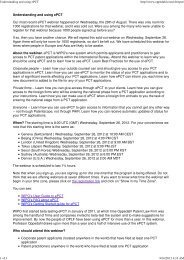Polaroid Corp. v. Eastman Kodak Co. - Oppedahl Patent Law Firm LLC
Polaroid Corp. v. Eastman Kodak Co. - Oppedahl Patent Law Firm LLC
Polaroid Corp. v. Eastman Kodak Co. - Oppedahl Patent Law Firm LLC
You also want an ePaper? Increase the reach of your titles
YUMPU automatically turns print PDFs into web optimized ePapers that Google loves.
Intellectual Property Library ISSN 1526-8535<br />
— U.S. —, 110 S.Ct. 725 (1990) (although fiberglass was not a noninfringing alternative<br />
to the patented foam insulation, the two were in direct competition and therefore, it was<br />
in the district court's province to consider that fact in assessing the appropriate reasonable<br />
royalty rate); Water Technologies <strong><strong>Co</strong>rp</strong>. v. Calco, Ltd., 850 F.2d 660, 673 [ 7 USPQ2d<br />
1097 ] (Fed. Cir.), cert. denied, — U.S. —, 109 S.Ct. 498 (1988) (as a basis for reversing<br />
the district court's award of lost profits, the court held that a finding of but/for causation<br />
was negated by the finding that the patentee's price significantly exceeded that of the<br />
infringer); Paper <strong>Co</strong>nverting Mach. <strong>Co</strong>. v. Magna-Graphics <strong><strong>Co</strong>rp</strong>., 745 F.2d 11, 21 [<br />
223 USPQ 591 ] (Fed. Cir. 1984) (in considering the magnitude of demand in a twoseller<br />
market, the court upheld the district court's consideration and rejection, on factual<br />
grounds, of the infringer's claims that consumers of the patented product would have<br />
foregone the purchase except for their lower price); Pfizer, Inc. v. International Rectifier<br />
<strong><strong>Co</strong>rp</strong>., 218 U.S.P.Q. 586 (C.D. Cal. 1983) (in deciding what demand would have been<br />
for certain prescription drugs in the absence of infringement, the court considered price<br />
and demand elasticities and competition from other non-infringing drugs).<br />
I find that conventional photography was not an acceptable substitute for instant<br />
photography during the period of infringement. <strong>Co</strong>mpetition between conventional and<br />
instant photograph (which changed throughout the ten years of infringement) did,<br />
however, affect the price that consumers were willing to pay for instant photography.<br />
Therefore, in Section B, Part 2, I have assessed what effect the competition would have<br />
had on <strong>Polaroid</strong>'s ability to charge more for its instant products and on the profitability of<br />
delaying the introduction of certain lower-priced products.<br />
B. The Relationship Between Marketing and Demand in the<br />
Market for Instant Photography.<br />
Legal Principles<br />
On its face, the inference that in a two-seller market, but for the infringement, demand for<br />
the patented product equals the combined sales of the patent owner and the infringer<br />
seems reasonable. Lam, Inc. v. Johns-Manville <strong><strong>Co</strong>rp</strong>., 718 F.2d 1056 [ 219 USPQ 670 ]<br />
(Fed. Cir. 1983). The rationale supporting this inference is the idea that when the<br />
infringement was occurring, the combined sales represent the number of consumers who<br />
desired the patented product. See Livesay Window <strong>Co</strong>. v. Livesay Indus. Inc., 251 F.2d<br />
469, 473 [ 116 USPQ 167 ] (5th Cir. 1958).<br />
[3] The law looks behind the facial appeal, however, and requires more of the patentee.<br />
The patent holder must show that it had the marketing capability to make the sales. State<br />
Indus., 883 F.2d at 1577; Datascope <strong><strong>Co</strong>rp</strong>. v. SMEC, Inc., 879 F.2d 820, 826-27 [ 11<br />
USPQ2d 1321 ] (Fed. Cir.), reh'g denied en banc, 1989 U.S. App. LEXIS 13416 (Fed.<br />
Cir. 1989), cert. denied , — U.S. —, 110 S.Ct. 729 (1990). Typically this requires proof<br />
of factors such as an adequate distribution system and sales personnel. See, e.g.,<br />
Datascope <strong><strong>Co</strong>rp</strong>., 879 F.2d at 827 (upholding the district court's determination that the<br />
patentee was not entitled to lost profits on infringer's foreign sales of heart catheters<br />
because patentee had no sales representative's assigned to foreign customers and never<br />
made "inroads in the area"); Yarway <strong><strong>Co</strong>rp</strong>. v. Eur-<strong>Co</strong>ntrol USA, Inc., 775 F.2d 268, 276 [<br />
227 USPQ 352 ] (Fed. Cir. 1985) (upholding the district court's decision to award the<br />
patentee profits on only eighty-five percent of the infringer's sales of desuperheaters<br />
<strong>Co</strong>pyright 2003, The Bureau of National Affairs, Inc. Reproduction or redistribution, in<br />
whole or in part, and in any form, without express written permission, is prohibited except<br />
as permitted by the BNA <strong>Co</strong>pyright Policy. http://www.bna.com/corp/index.html#V<br />
18





